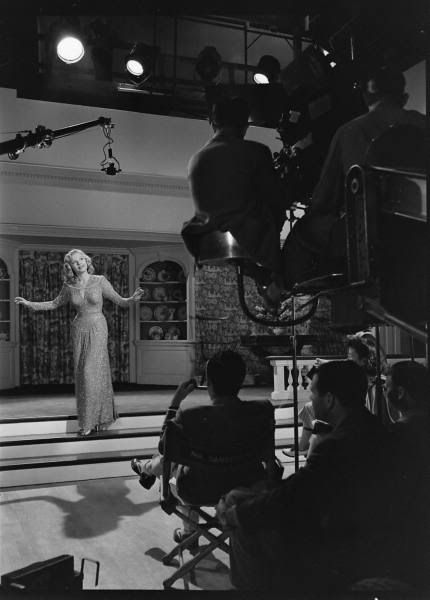 |
| Photo from LIFE Photo Archive Rancho Drive-In Theater in San Francisco, August 1948 |
 |
| Photo |
The Drayton's views are challenged when their engaged daughter brings home her black fiancé.
Trivia: This was Spencer Tracy's last appearance on film. He passed 17 days after filming ended. At the time the movie was conceived, interracial marriage was still illegal in a number of states. By the time the movie was in theaters, the US Supreme Court in the case of Loving v. Virginia declared anti-miscegenation laws unconstitutional.
 |
| Photo |
Joey Evans has it made. Rich widow Vera Simpson provides financial security to Joey and his every whim, but along comes beautiful ingenue Linda English and now Joey is caught between the two women.
Trivia: Rita Hayworth plays what is supposed to be an older cougar type who is keeping Joey as her arm candy, but in reality Rita Hayworth was only in her late 30's when she played the role and actually 3 years younger than Frank Sinatra.
 |
| Photo |
During a trip to a small Northern California town, Melanie Daniels is met with bizarre attacks by vicious birds who seem to be targeting her.
Trivia: The famous depiction of a woman screaming whilst being attacked by birds that appears on the movie poster is actually Jessica Tandy and not Tippi Hedren. Tippi also is not the one that Rod Taylor as Mitch is carrying down the stairs from the bedroom after Tippi's character has been trapped in a room with the birds, it is actually Ms. Hedren's stand in since Tippi Hedren was hospitalized from exhaustion after spending a week filming that scene. One ending that was considered was showing the Golden Gate Bridge covered in birds and Hitchcock purposely did not include a "The End" at the closing of the film to emphasize the unending terror of the birds.
 |
| Photo |
Based on the life of Florenz Ziegfeld, Jr., the famous producer of numerous extravagant stage revues known as the Ziegfeld Follies.
Trivia: Billie Burke (best known for her portrayal of Glinda the Good Witch from MGM's The Wizard of Oz movie (1939), was married to Florenz Ziegfeld from 1914 until his death in 1932. Louise Rainer who played Ziegfeld's common law first wife Anna Held was the first woman to win two Academy awards in a row, the first for this movie and the next for her role in The Good Earth (1937).
 |
| Photo |
Michael O'Hara meets beautiful Elsa Bannister and is convinced to join her and her husband on a yachting cruise but is soon embroiled in a bizarre murder plot.
Trivia: The movie was shot in San Francisco, although the setting on film is supposed to be New York. The yacht used for filming, the Zaca, belonged to Errol Flynn at the time and despite having been almost destroyed throughout the years from neglect and ownership disputes, it now sails out of Monte Carlo and is considered to be one of the world's finest yachts (and quite possibly haunted). The film was not a success, and many people believe that it may have had to do with the decision by Welles to have Rita Hayworth cut her famous red hair short and dye it blonde.
 |
| Photo |
Private detective Sam Spade gets involved in a twisted quest for a priceless statuette that involves several eccentric criminals and a beautiful liar.
Trivia: This was John Huston's directorial debut. Although there were several falcon statuettes used during filming, Bogart dropped one of the original ones cast out of lead (others were cast out of resin). This first one can be seen on display at the Warner Bros., movie museum with visible dents from being dropped. To give Mary Astor's character the appearance of being nervous and breathless, John Huston would run with her around the set several times before shooting her scenes.
 |
| Photo |
Retired private investigator John 'Scottie' Ferguson becomes obsessed with his client and old friend's young beautiful wife who he has been hired to follow.
Trivia: James Stewart's character eventually finds Kim Novak's character at The Empire Hotel at 940 Sutter St. in the heart of San Francisco. This hotel is now known as Hotel Vertigo and the room (Room 501) where the scenes took place is still reminiscent of how it appears on film. The film was poorly received upon its release, but is now considered one of Hitchcock's greatest films and in 2012 it replaced Citizen Kane in the Sight and Sound critics' poll as the greatest film of all time.



























